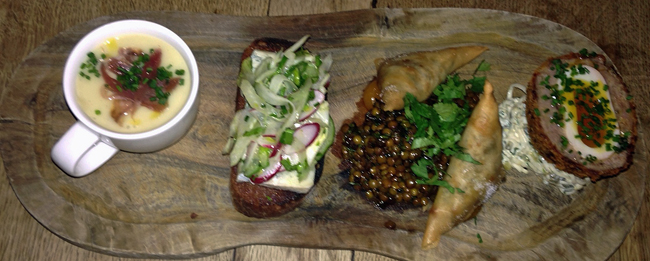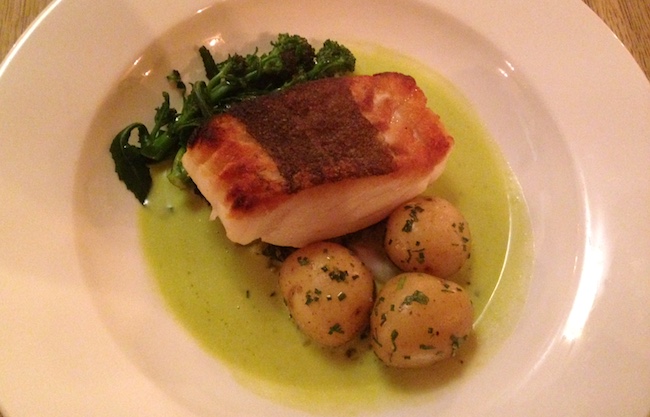
The Fat Fox Inn is located in the centre of one of England’s smallest historic market towns, Watlington in Oxfordshire. A gastropub with nine recently refurbished en suite rooms, it is an ideal venue for discerning guests seeking a short break with good quality food and stylish accommodation. There is easy access from Junction 6 of the M40, with Oxford 13 and London 45 miles away. Ramblers also are attracted to the town, which lies close to the Ridgeway, a national trail which runs along the Chilterns. Not that locals who just wish to drink are absent from the clientele, given the warmth of welcome and the efficiency of service. Owner John Riddle is particularly keen to ensure that, unlike food led pubs elsewhere, The Fat Fox Inn does not turn primarily into a restaurant, with scant attention and limited space given to those who only request, say, a pint of Brakspear’s bitter or Oxford Gold. Indeed, the restaurant and bar occupy roughly half the space each.
The columned entrance porch of the two storeyed whitewashed Georgian building leads to the bar area on the right and restaurant on the left, with seating for 30 and 28 respectively. (The same menu is available in both.) Wooden flooring with oriental rugs are evident throughout. Whereas the bar has a classic rustic feel, with low beamed ceiling, Inglenook fireplace and bench seating, the restaurant has a more dated, dare I say 18th Century character, in line with the origins of the building. Bold crimson wallpaper, large gilt framed mirrors, well-spaced tables of various sizes, seating of varying comfort, and mood lighting characterise the eclectic but well-proportioned room.

Although the décor might not be to everyone’s taste, few would not be enamoured of the food. John Riddle, who after six years, sold his brasserie in Drury Lane to buy the Fat Fox Inn, is fully aware of the demands of a discerning, food conscious clientele. In Stewart Lennox he has found a head chef of distinction. Top quality produce is carefully sourced, much coming from trusted suppliers in south Oxfordshire. For instance, Toulouse sausage comes from the renowned Calnan brothers in Watlington itself. On the other hand, Skrei Cod, probably the finest of the species, is caught off the coast of Norway. A daily changing menu ensures maximum use is made of seasonal ingredients. The menu is sensibly short, bearing in mind that a team of up to four in the kitchen have to cater for large numbers at weekends. The choice comprises the chef’s interpretation of traditional British classics with other dishes reflecting continental influences. On the evening we visited, Toad in the Hole and battered haddock with crushed peas, tartare sauce and chips appeared alongside Toulouse sausage with cassoulet and Gnudi with braised rappini, Parmesan and broccoli as choices for the main course.
A balance of tastes and textures, with harmonious combinations of ingredients, are evident throughout. Main components are allowed to shine with accurate seasoning and precisely timed cooking. Techniques are classical with, thankfully, not a trace of faddishness. This is honest, unpretentious cooking of a high standard and is recognised by a listing in the Michelin UK and Ireland Guide.
Prices reflect the quality of ingredients and skill in cooking. Starters average £6-£7, mains £10-£20, sides £3, and desserts £6. A select range of English cheeses is charged £2.50 per piece or four for £10. The select wine list which avoids greedy mark ups is mainly Old World, most being available by the glass
We decided to sample small portions of four starters.

Haddock chowder was suitably thick and smooth being topped with Serrano ham which also acted as a seasoning. A blue cheese scone added a little spicy piquancy, texture and substance – perhaps unnecessary – but overall this was a comforting, hearty starter.
By contrast, Gorganzola on toast with radish, celery and fennel salad was lively and fresh, the saltiness of the soft cheese being balanced by the peppery qualities of the radish and the crispness of the celery. The addition of fennel gave a mild aniseed hit which lifted the whole combination.
The warm Fat Fox Scotch egg was properly executed with a runny yolk, moist, well-seasoned sausage meat filling, and a crisp coating The celeriac remoulade which accompanied it had a good balance of mustardy creaminess and slight acidity.
Best of all were the curried cauliflower samosas with their crisp, light pastry and delicately spiced filling. Served with spiced lentils and sweet and sour sauce, this dish combined an explosion of flavours and contrasting textures which proved most satisfying.
For mains, it was good to see the Bavette steak on the menu. Popular in France, but underrated in the UK, it is cheaper but superior in flavour to the more expensive cuts. Here the meat was accurately timed and well rested to a medium rare, maximising its deep beefy flavour and fine texture. Enlivened by the parsley, lemon and garlic in a dressing of gremolata, and served with crisp straight cut chips, watercress and heritage carrots, this was a simple, well executed dish needed nothing more – except some tomato ketchup – to complete it.
How pleasing to see Skrei cod, another ingredient not commonly used in UK restaurants. Again, precise cooking – seared in the pan and finished in the oven – did full justice to the clean, muscular flesh which its translucent flakes. Dressed simply with herbed new potatoes and sprouting broccoli, the dish was finished with an innovative wasabi and cucumber sauce which was clean, herbal and not overpowering.

Desserts were not quite as accomplished as the savoury courses but still a credit to the kitchen. In particular, the lemon roulade had a crisp crust accentuated with toasted hazelnuts, and soft meringue encasing a generous cream filling. The lemon curd had a well-judged balance of sweetness and acidity.

Although a half pint mug containing layers of all the sweet options was, perhaps, ill conceived – too heavy and rich but a delight for those with the capacity – this was redressed by velvety smooth ice creams with unusual flavours such as brioche, cookie dough and lemon meringue.
Overall, this was an enjoyable three course meal, enhanced by the cheerful, helpful service of Henry who looked after us for the evening. Fine Dining Guide hopes to revisit in the summer to sample other dishes from the ever changing menu and perhaps stay overnight in one of the luxuriously appointed rooms.



